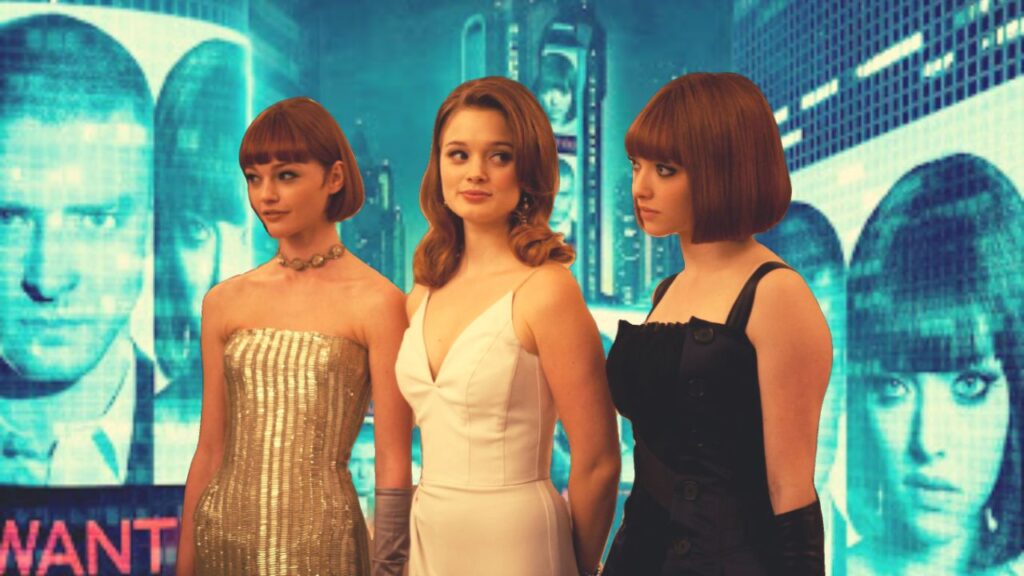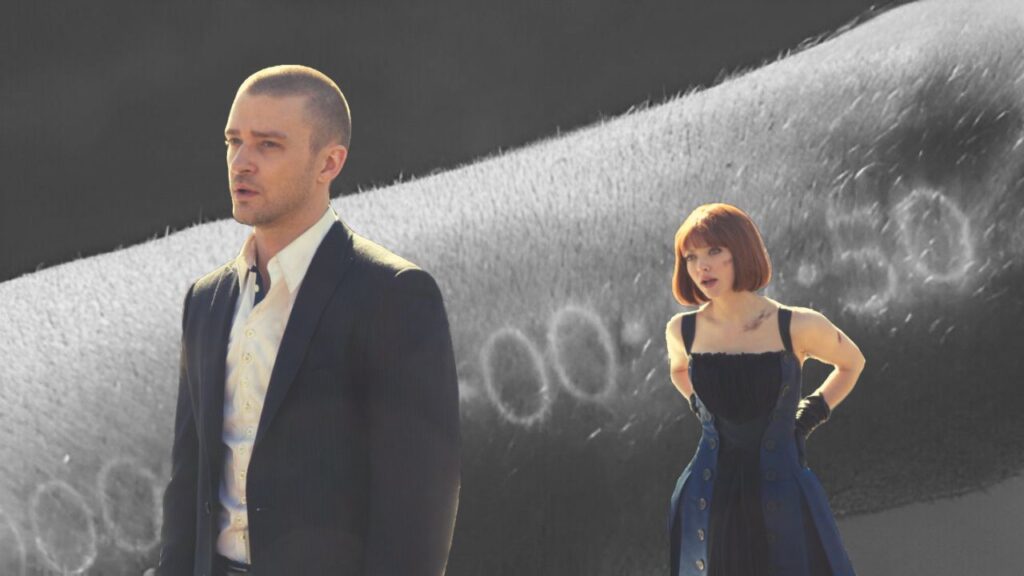This post includes a brief plot summary, an analysis and an explanation about the ending of the 2011 film “In Time”. Beware of spoilers.

Imagine a world where time is the ultimate currency, and the wealthy can live forever while the poor struggle to survive from day to day. In the 2011 film ‘In Time,’ director Andrew Niccol paints a dystopian picture where time literally means money. Starring Justin Timberlake as Will Salas and Amanda Seyfried as Sylvia Weis.
The plot of “In Time” presents a thought-provoking premise that challenges the audience to reflect on the value of time and social inequalities.
Set in a dystopian future, “In Time” presents a world where people are genetically engineered to stop aging at 25. However, this “blessing” comes with a caveat: after that, people have to pay to continue to live. As a result, the poor have to struggle harder to stay alive than the rich.
The protagonist of this story is Will Salas, a young man who lives in Dayton, a poor area. However, everything changes when he saves the life of a complete stranger. That same man happened to have a lot of time on his hands, literally. And he gifts all of it to Will as a token of appreciation.
Sadly for Will, his new-found fortune also came with a great loss: his mother “ran out of time” before he could give her the good news. Now, as a wealthy man, Will leaves Dayton and swears revenge on the ultra-rich, the inhabitants of New Greenwich.
At his new “place”, Will meets Philippe Weis, a man who made most of his fortune “lending time” to people. Will beats Philippe at a poker game. Winning more time was definitely a very satisfying experience for Will, but at the moment, all his eyes are on Sylvia Weis, Philippe’s daughter.
Just when he thought his life had turned around, a bunch of timekeepers stormed into Philippe’s party and captured Will. Leon, a senior officer, believes that Will is a time thief and therefore confiscates all his time. Out of fear, Will kidnaps Sylvia. During the escape, Will and Sylvia encounter real “time thieves”. Since Will didn’t have much time on him, they took most of Sylvia’s.
Later on, Sylvia joins Will in his fight to help the poor. What is the one thing that these people don’t have? Time. Therefore, Sylvia and Will start robbing Philippe’s time-lending facilities and giving the time to those in need. However, there is a bigger heist on their horizon: a case containing one million years located at Philippe’s vault.
The ending of “In Time” shows Will and Sylvia leaving Philippe’s building and successfully distributing the time among the people in Dayton. Eventually, Leon stops chasing the couple because he runs out of time. From that point on, Will and Sylvia continue to join efforts to rob larger banks and gift the time away.
Will Salas and Sylvia Weis represent the disparities between the wealthy and the poor. Each character provides insights about the complexities of social stratification.
The protagonist of “In Time”, Will Salas, is a man driven by his desire to avenge his mother’s death. Her passing is a product of the social inequalities between the rich and the poor. As a part of his grieving process, Will decided to take action against the status quo of this time-based currency society.
While Will represents the struggling working class, Sylvia Weis is the complete opposite. She belongs to the elites, who are wealthy enough to live a carefree life and not worry about “time”. Her encounter with Will made her aware of the harsh reality of the time disparity between the rich and the poor. As a result, she decides to join Will in his fight, and she even defies her own father in the process.
Side note: Although Will and Sylvia get the most screen time in the film, Leon is probably one of the puzzling characters in “In Time”.
When it comes to social status, Leon is not privileged like Philippe Weis, but he’s doing better than many of the inhabitants of Dayton. However, this timekeeper insists on hunting down Will and Sylvia to maintain the existing social order when his actions don’t really benefit him at all. Quite the contrary, Leon’s actions only reinforce the current oppressive system.

Despite being set in a dystopian future, “In Time” shares a lot of parallels with our current contemporary society, which deserves its own analysis.
A time-based economy has a lot of social implications. If everything is paid with “time”, then the wealthy will become almost immortal, while the poor have their lives on the line all the time. An underprivileged individual in this society cannot afford to skip a single day of work, as it has life-and-death consequences.
The world of “In Time” serves as a metaphor for real-world economic disparities. Will Salas would never be able to earn his way out of Dayton. It’s literally too expensive. The toll fees between areas are just one of many barriers that keep people in their respective areas, or, in other words, their social status.
However, the social elevator of “In Time” is not the only one that is broken, the one from our current society is too. There is a widening gap between the rich and poor, which is making it harder and harder for individuals to climb up the social ladder.
Having said that, “In Time” provides a harsh critique of unregulated capitalism and the pursuit of wealth. For instance, Philippe Weis is a man who made his fortune out of others’ desperation. His time-lending facilities are lending time to people who don’t have it. And even worse, they will never be able to repay what they owe, making them stay in a permanent cycle of debt.
Final Thoughts
“In Time” is an intriguing tale that explores in an original manner the concept of time as currency. Due to its interesting premise and exciting fast pace, the film keeps the audience on their toes, curious about what’s going to happen next.
Although the film had a very strong premise, the ending of “In Time” didn’t quite deliver. Also, the performance of the leading man, Justin Timberlake, was subpar. Had they chosen a more seasoned or talented actor, the character of Will Salas would’ve been much more memorable.
As mentioned before, the film’s ending doesn’t quite live up to its strong start. “In Time” does a great job at highlighting the differences between the rich and poor but offers a terrible solution to the problem. The key to societal inequality is not to rob the rich but to promote a system that fosters social mobility.
Overall, “In Time” is a compelling watch, despite its minor shortcomings. Andrew Niccol’s storytelling style is visually engaging and reminds the viewers of the importance of creating a society where opportunities are available to all, regardless of their social status.


